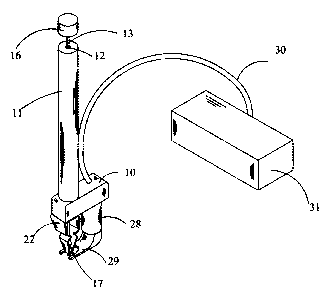Some of the information on this Web page has been provided by external sources. The Government of Canada is not responsible for the accuracy, reliability or currency of the information supplied by external sources. Users wishing to rely upon this information should consult directly with the source of the information. Content provided by external sources is not subject to official languages, privacy and accessibility requirements.
Any discrepancies in the text and image of the Claims and Abstract are due to differing posting times. Text of the Claims and Abstract are posted:
| (12) Patent Application: | (11) CA 2504050 |
|---|---|
| (54) English Title: | SMD CHIP HANDLING APPARATUS |
| (54) French Title: | DISPOSITIF DE MANUTENTION DE PUCE CMS |
| Status: | Deemed Abandoned and Beyond the Period of Reinstatement - Pending Response to Notice of Disregarded Communication |
| (51) International Patent Classification (IPC): |
|
|---|---|
| (72) Inventors : |
|
| (73) Owners : |
|
| (71) Applicants : |
|
| (74) Agent: | |
| (74) Associate agent: | |
| (45) Issued: | |
| (22) Filed Date: | 2005-04-11 |
| (41) Open to Public Inspection: | 2006-10-11 |
| Availability of licence: | N/A |
| Dedicated to the Public: | N/A |
| (25) Language of filing: | English |
| Patent Cooperation Treaty (PCT): | No |
|---|
| (30) Application Priority Data: | None |
|---|
The apparatus is for securely fetching and positioning an SMD chip on a
printed circuit
board and soldering the same to the board. Two spring plates form the clasping
fingers which are
wedged apart to a width larger than the width of the SMD chip by an expander
formed on an
elongated rod slidably mounted within a vertical tubular housing. An SMD chip
may be safely
fetched by pressing the rod on the top of the SMD with a continuous depressing
motion until the
fingers clasp the SMD chip safely therebetween. A soldering unit with a
bifurcate soldering head
located juxtaposed to the fingers is operative to solder the SMD chip to the
printed circuit board
while the SMD chip is safely held in place.
Note: Claims are shown in the official language in which they were submitted.
Note: Descriptions are shown in the official language in which they were submitted.

2024-08-01:As part of the Next Generation Patents (NGP) transition, the Canadian Patents Database (CPD) now contains a more detailed Event History, which replicates the Event Log of our new back-office solution.
Please note that "Inactive:" events refers to events no longer in use in our new back-office solution.
For a clearer understanding of the status of the application/patent presented on this page, the site Disclaimer , as well as the definitions for Patent , Event History , Maintenance Fee and Payment History should be consulted.
| Description | Date |
|---|---|
| Revocation of Agent Requirements Determined Compliant | 2021-04-01 |
| Application Not Reinstated by Deadline | 2010-04-12 |
| Time Limit for Reversal Expired | 2010-04-12 |
| Deemed Abandoned - Failure to Respond to Maintenance Fee Notice | 2009-04-14 |
| Application Published (Open to Public Inspection) | 2006-10-11 |
| Inactive: Cover page published | 2006-10-10 |
| Inactive: First IPC assigned | 2005-06-21 |
| Filing Requirements Determined Compliant | 2005-05-16 |
| Inactive: Filing certificate - No RFE (English) | 2005-05-16 |
| Application Received - Regular National | 2005-05-16 |
| Small Entity Declaration Determined Compliant | 2005-04-11 |
| Abandonment Date | Reason | Reinstatement Date |
|---|---|---|
| 2009-04-14 |
The last payment was received on 2008-03-27
Note : If the full payment has not been received on or before the date indicated, a further fee may be required which may be one of the following
Please refer to the CIPO Patent Fees web page to see all current fee amounts.
| Fee Type | Anniversary Year | Due Date | Paid Date |
|---|---|---|---|
| Application fee - small | 2005-04-11 | ||
| MF (application, 2nd anniv.) - small | 02 | 2007-04-11 | 2007-02-05 |
| MF (application, 3rd anniv.) - small | 03 | 2008-04-11 | 2008-03-27 |
Note: Records showing the ownership history in alphabetical order.
| Current Owners on Record |
|---|
| CHI MING WONG |
| WOON-WAI CHAN |
| Past Owners on Record |
|---|
| None |